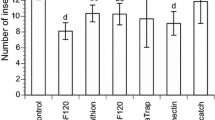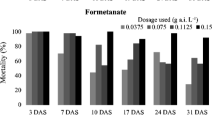Abstract
Laboratory and field studies were made to investigate the toxicity, mode of action, and persistence of technical DDT and y BHC when applied to the cashew in Sri Lanka to control the mirid bug, Helopeltis antonii Sign. The insecticides were tested at concentrations previously used in field trials.
Mirid nymphs were placed on the nuts and the rate of knockdown and mortality after exposure for a test period was recorded. These tests showed that BHC had a higher toxicity and acted more quickly than DDT. BHC had a powerful and transient fumigant action over DDT, which had no fumigant effect at all. Persistence was studied by treating cashew leaves and nuts growing under natural conditions and then testing the residual deposit at intervals.
It was concluded that BHC would be more effective than DDT when treating mature cashews because, in addition to its higher toxicity and quicker action, its fumigant action would compensate for incomplete coverage by low-volume spraying.
Similar content being viewed by others
References
Anon (1956) West African Cocoa Research Institute, Quarterly Report No. 41, Jan-March 1956. Ghana.
Anon (1957) Annual Report of the Department of Agriculture (Ghana) for the Year 1955-56. Ghana.
Anon (1966) Annual Progress Report of the Central Cashew Research Station, 1964-65. Ullal, India.
Anon (1969) Annual Progress Report of the Central Cashew Research Station, 1968-69. Ullal, India.
Damodaran V. K. and Balakrishnam Nair M. P. (1969) Studies on the insecticidal control of Helopeltis antonii Signoret on cashew. Agric. Res. J., Kerala, 9, 28–30.
Nambiar K. K. N., Sarma Y. R. and Pillai G. B. (1973) Inflorescence blight of cashew (Anacardium occidentale L). J. Plant Crops 1, 44–46.
Pillai G. B. and Abraham V. A. (1975) In CPCRI Annual Report for 1974, pp. 132–133. Kasaragod, India.
Pillai G. B., Dubey O. P. and Vijay Singh V. (1976) Pests of cashew and their control in India, a review of current status. J. Plant Crops 4(2), 37–50.
Vijay Singh V. and Pillai G. B. (1979) Field evaluation of the efficacy of four insecticides in the control of tea mosquito infestation in cashew. Abstracts, International Cashew Symposium, March 1979. Cochin, India.
Taylor D. J. (1957) Efficiency of fog application of BHC. Report of the West African Cocoa Research Institute, 1955-56, pp. 50–51.
Author information
Authors and Affiliations
Rights and permissions
About this article
Cite this article
Jeevaratnam, K., Rajapakse, R.H.S. Studies on the Chemical Control of the Mirid Bug, Helopeltis Antonii Sign, in the Cashew. Int J Trop Insect Sci 1, 399–402 (1981). https://doi.org/10.1017/S1742758400000758
Received:
Revised:
Published:
Issue Date:
DOI: https://doi.org/10.1017/S1742758400000758




